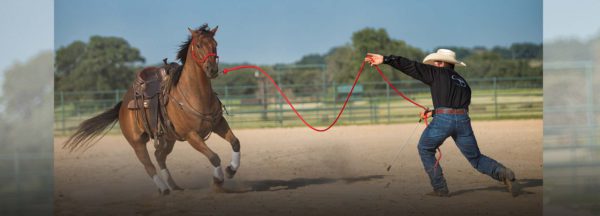Three Groundwork Exercises That Will Change the Partnership You Have With Your Horse

Groundwork for Horses
When Clinton works with the group of horsemen in his Rancho Murieta, California Fundamentals Clinic, January 13th – 15th, he’ll teach them the groundwork and riding exercises that make up the Fundamentals level of the Method. Included in the exercises Clinton will teach the horsemen are three groundwork exercises that are game changers when it comes to interacting with horses.
Backing
There’s no exercise more effective to earn a horse’s respect than backing. The better you can get a horse to back up, the more respectful and responsive he will be in everything else that you ask him to do. A good backup is the foundation of the stop as well as collection. A respectful horse backs up with energy any time you want. A disrespectful horse ignores you and walks toward you with pushy, dominant behavior. Clinton teaches horses four separate methods of backing:
Method 1: Tap the Air
Method 2: Wiggle, Wave, Walk and Whack
Method 3: Marching
Method 4: Steady Pressure
Each of these four methods share a common overall goal: To get the horse to back up and move respectfully out of your space any time you ask. It’s important to teach the horse each method, not just one or two, because each one teaches him to back away from a different type of pressure.
Lunging for Respect
This exercise is Clinton’s effective spin on a traditional practice that’s often overused and abused in the horse world. The goal of this exercise is to send the horse out onto a circle by just pointing and have him trot energetically around you without pulling on the lead rope. Then, when you look toward his hindquarters, the horse should yield and face you with two eyes. Notice that it’s called “Lunging for Respect.” It’s not called “Lunging to Get the Buck Out of the Horse” or “Lunging to Tire Him Out.” It’s called Lunging for Respect. You earn a horse’s respect by moving his feet forwards, backwards, left and right and always rewarding the slightest try. So the more you can get his feet to move and change direction, the more respectful the horse will get, and the more he’ll use the thinking side of his brain, which will make him safer and more trainable. This exercise really focuses on using your body language to send the horse away from you and then getting him to face you with two eyes again. It’s a great tool to use when you need to get excess energy out of your horse. Any time you go to work with him and he’s fresh, spend a few minutes practicing Lunging for Respect and he’ll be in a much better frame of mind. It’s also a great way to wake up a lazy horse so that by the time you’re ready to ride him he’s willing to go forward and doesn’t have a sorry attitude about moving his feet.
Flexing
This exercise lays the foundation for teaching a horse to be soft and supple. The goal of the exercise is to ask the horse to flex his head and neck to one side of his body by picking up on the lead rope with only two fingers. The horse’s nose should be able to touch his belly in the same place the girth would normally be. The exercise will teach your horse to respect halter pressure in general so that he doesn’t pull and lean on it during groundwork for horses exercises. Getting your horse soft and supple on the ground will transfer to when you ride him. If your horse can’t flex and be soft and supple on the ground, he’s not going to flex and be light under saddle, either. Lateral flexion is the key to vertical flexion and to getting a horse to collect.
To learn more about the Fundamentals level of the Method and the groundwork and riding exercises covered in it, visit our website. Get more information about Clinton’s Fundamentals Clinic in Rancho Murieta at the Murieta Equestrian Center, January 13th – 15th at downunderhorsemanship.com. The clinic is open to participants and spectators. Spectator tickets may be purchased online, by calling 888-287-7432 or at the facility.
